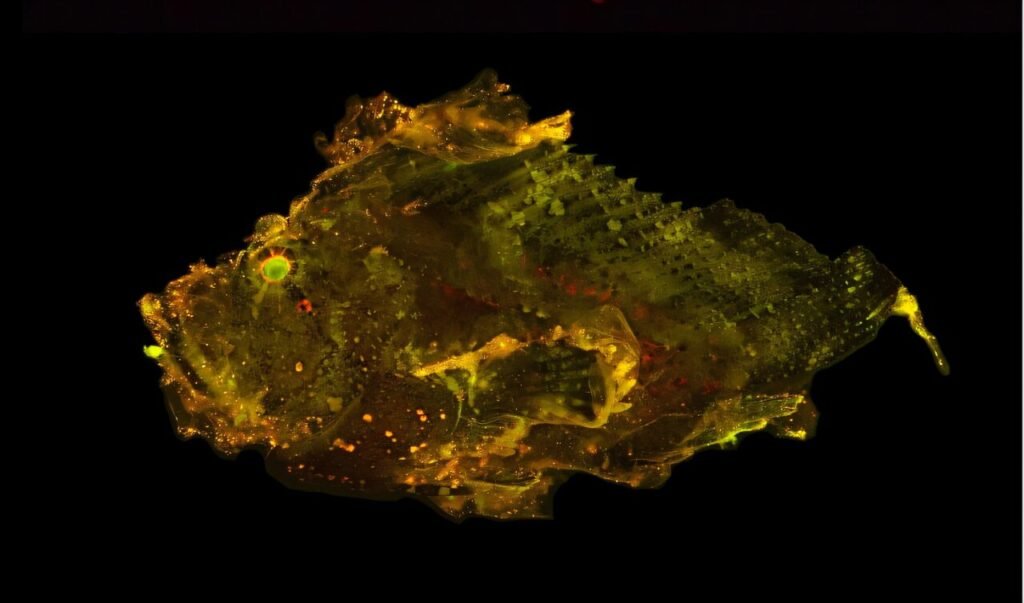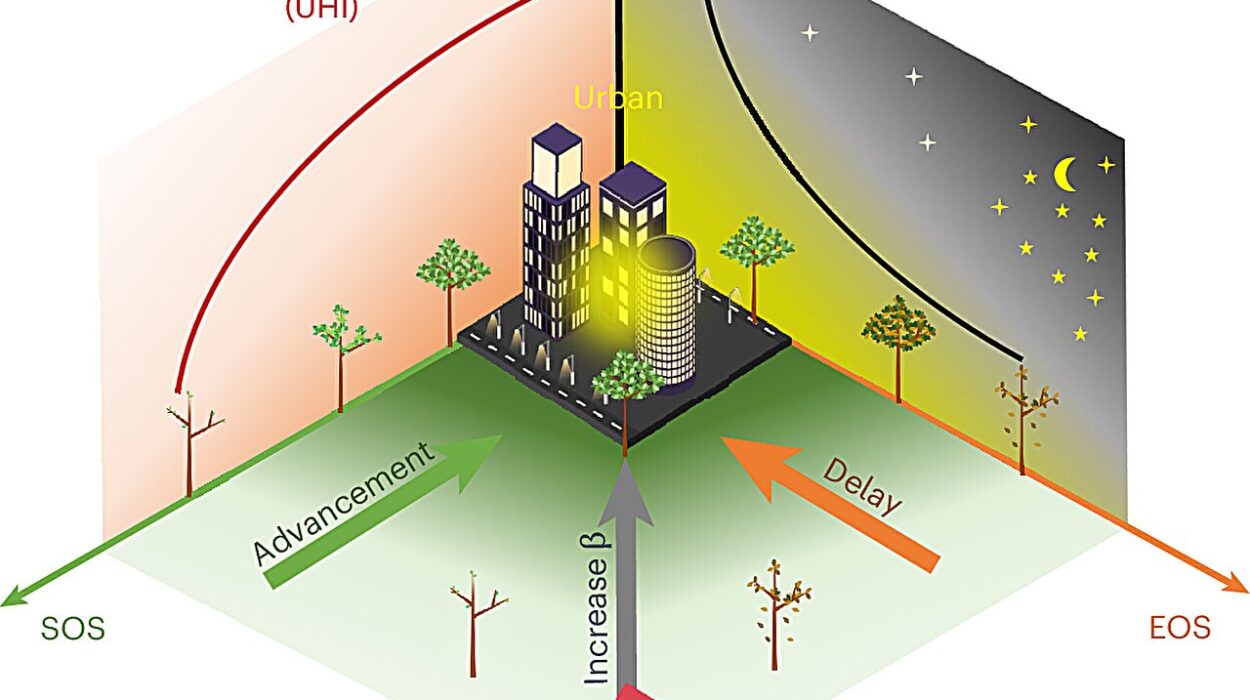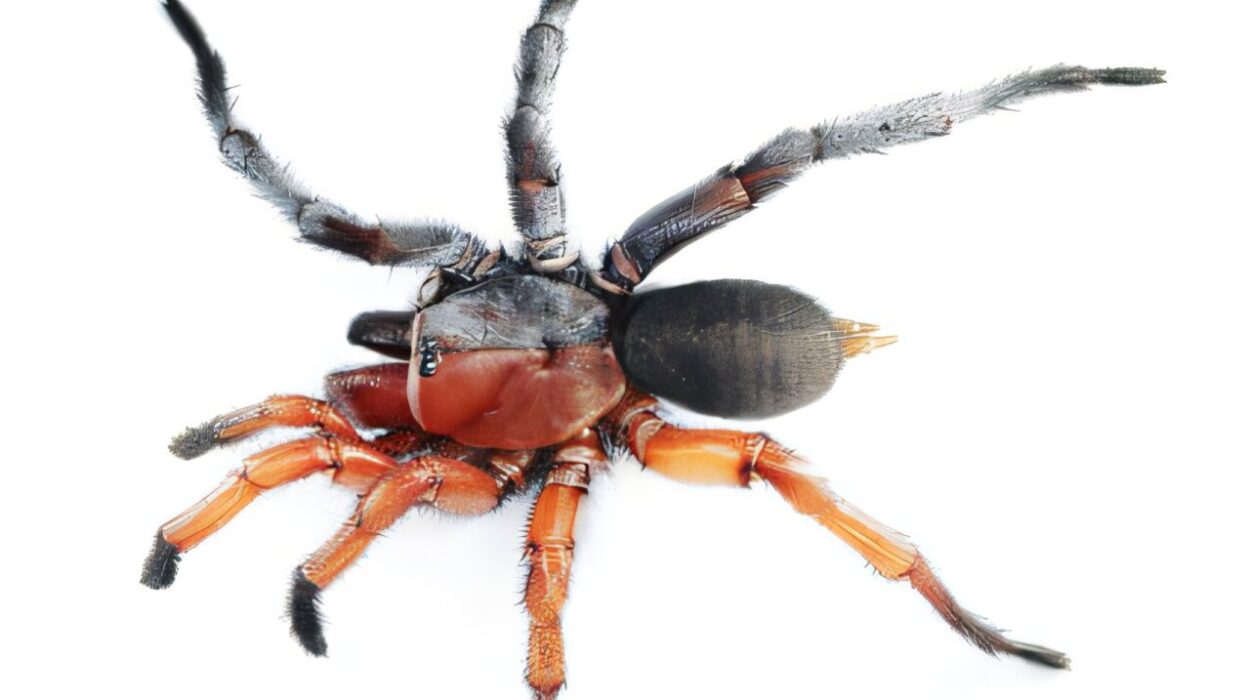In the depths of the ocean, where sunlight barely penetrates and shadows rule, something magical happens. Marine fishes glow—not with the cold gleam of bioluminescence, but with the vibrant, electric shimmer of biofluorescence. When struck by blue or ultraviolet light, these fishes transform it, reemitting it as brilliant flashes of green, yellow, orange, or red. And now, thanks to two groundbreaking studies led by researchers at the American Museum of Natural History, we know this natural light show began over 112 million years ago.
Published in Nature Communications and PLOS ONE, these complementary studies pull back the curtain on a phenomenon that has long dazzled scientists and divers alike, revealing that biofluorescence is more widespread, ancient, and diverse than anyone previously imagined.
It’s not just a pretty glow—it’s a story of survival, communication, and evolution, etched in color beneath the waves.
Lighting Up the Past: A 112-Million-Year Legacy
When Emily Carr, a Ph.D. student at the Museum’s Richard Gilder Graduate School, began cataloging biofluorescent marine fishes, she wasn’t expecting to uncover a lineage that stretched back to the age of dinosaurs. But as she and her colleagues combed through fossil records, genetic lineages, and physical traits of modern fish, a vivid evolutionary timeline came into focus.
Their work led to the most comprehensive survey of biofluorescent bony fishes—known as teleosts—ever attempted. The list includes 459 species, 48 of which had never before been identified as fluorescent. From slender eels to jewel-toned reef dwellers, these creatures use biofluorescence in ways we are only beginning to understand.
“Researchers have known for a while that biofluorescence is quite widespread in marine animals, from sea turtles to corals, and especially among fishes,” Carr said. “But to really get to the root of why and how these species use this unique adaptation—whether for camouflage, predation, or reproduction—we need to understand the underlying evolutionary story.”
And that story begins not in the coral-rich tropics of today, but in the ancient oceans of the Early Cretaceous, with the first known biofluorescent fishes—eels—glimmering in prehistoric twilight.
Reef Revolution: A Fluorescent Explosion After Extinction
The study’s timeline reveals that the evolutionary arc of fish biofluorescence bent sharply upward following a cataclysmic event: the Cretaceous-Paleogene (K-Pg) extinction about 66 million years ago. As the dinosaurs vanished and ecosystems reshuffled, coral reefs began to rise—and with them, so too did a spectacular surge in fluorescent fish.
According to the findings, fish that live on or near coral reefs developed biofluorescence at rates up to ten times faster than their non-reef relatives. The majority of the 459 identified fluorescent species today are associated with reef environments.

“This trend coincides with the rise of modern coral-dominated reefs and the rapid colonization of reefs by fishes,” Carr explained. “It suggests that the emergence of these vibrant reef habitats could have facilitated the diversification of fluorescence in reef-associated teleosts.”
In essence, as reefs flourished, so did the underwater light show—an evolutionary dance of color and light that continues to pulse across today’s oceans.
A Spectrum Beyond Sight: The Hidden Colors of Biofluorescence
But it wasn’t just the age of fluorescence that surprised researchers—it was its breathtaking diversity.
In the PLOS ONE companion study, Carr and her team turned their focus to the colors themselves. Using a specialized photography setup that involved ultraviolet and blue excitation lights and emission filters, they examined specimens collected over 15 years of Museum expeditions, from the warm waters of the Solomon Islands and Thailand to the icy coasts of Greenland.
What they found was an oceanic rainbow previously invisible to human eyes. Some fish families exhibited as many as six distinct emission peaks—meaning they could fluoresce in multiple colors across a wide spectrum. This is far more variation than previously recorded and hints at a kaleidoscope of biological communication systems.
“The remarkable variation we observed across a wide array of these fluorescent fishes could mean that these animals use incredibly diverse and elaborate signaling systems based on species-specific fluorescent emission patterns,” said Dr. John Sparks, the Museum curator who advised Carr and co-authored both studies.
It’s as if each fish has its own language of light—signals and displays crafted over millions of years not just to dazzle, but to communicate, attract mates, ward off predators, or slip unseen into the reef shadows.
Why Does It Matter? More Than Just a Glow
These findings aren’t just fascinating for marine biologists and deep-sea photographers. They have real-world implications for science, medicine, and technology.
Fluorescent proteins, many of which are derived from marine organisms, are already used in biomedical research for disease diagnosis, imaging, and targeted therapy. The discovery of new wavelengths and proteins in these fish opens the door to novel applications in biotechnology, from more precise cancer detection to innovative bioengineering tools.
Moreover, the evolutionary patterns uncovered in the study may help scientists predict how reef ecosystems might respond to environmental stress. If fluorescence played a role in how reef fishes diversified and adapted post-extinction, it could play a similar role in today’s rapidly changing seas.
“As these studies show, biofluorescence is both pervasive and incredibly phenotypically variable among marine fishes,” Sparks said. “What we would really like to understand better is how fluorescence functions in these highly variable marine lineages, as well as its role in diversification.”
Beneath the Surface: A Glowing World Yet to Explore
Walk along a coral reef under moonlight, and to the naked eye, the world is dark and still. But shine a blue or ultraviolet light and the reef erupts in spectral wonder—fish glowing like neon signs, scales shimmer in fiery red, fins pulsing with jungle-green, tails lit up in lemon-yellow.
These colors are invisible in daylight and often unnoticed by divers. But to the fish themselves, it may be an essential part of life. A hidden language. A guide through shadowy reefs. A legacy of resilience born in the wake of planetary extinction.
The work by Carr and her team reminds us that the ocean is still full of secrets, and that evolutionary stories can lie hidden in the flicker of a fin or the glint of a scale.
They also remind us that, even in science, beauty matters. Understanding fluorescence isn’t just about mapping proteins or plotting genetic branches—it’s about recognizing the strange, beautiful ways life finds to endure, adapt, and communicate in the darkest corners of our world.
As climate change and human activity continue to stress coral reefs and marine habitats, unlocking the mysteries of biofluorescence may help protect the species that depend on them. Because in those hidden glows, nature may be sending us messages we’ve only just learned how to see.
References: Emily M. Carr et al, Marine fishes exhibit exceptional variation in biofluorescent emission spectra, PLOS One (2025). DOI: 10.1371/journal.pone.0316789
Emily M. Carr et al, Repeated and widespread evolution of biofluorescence in marine fishes, Nature Communications (2025). DOI: 10.1038/s41467-025-59843-7






